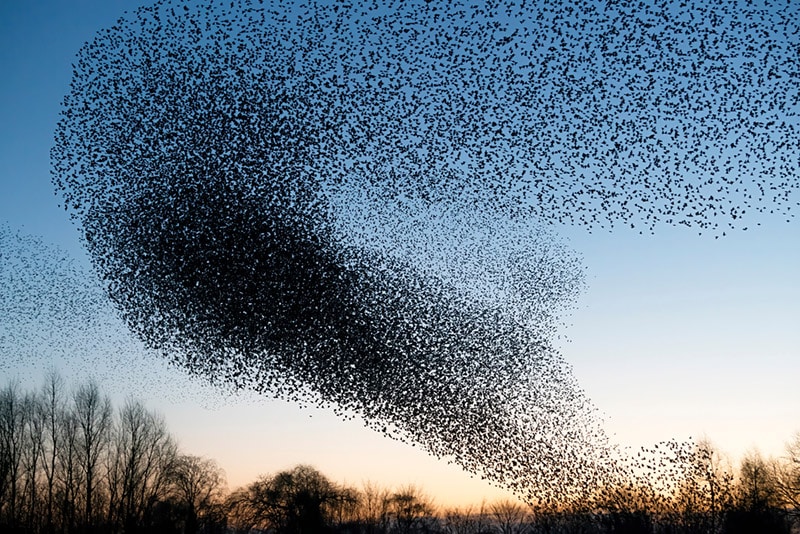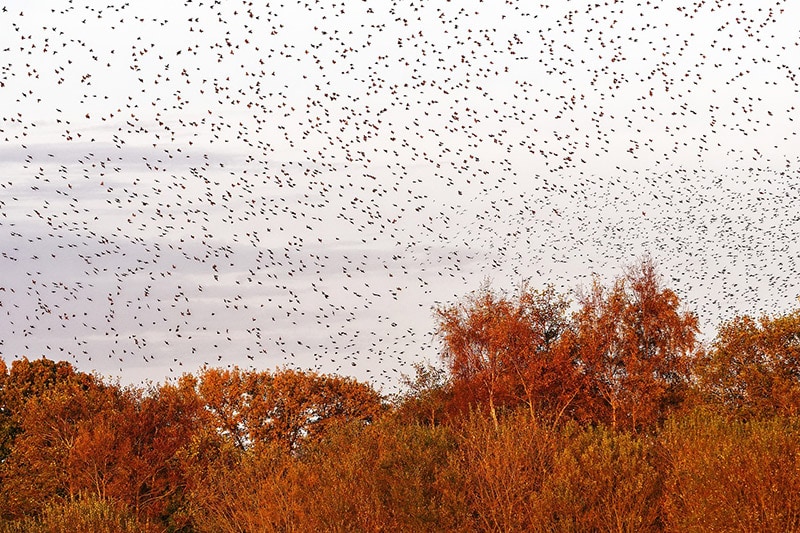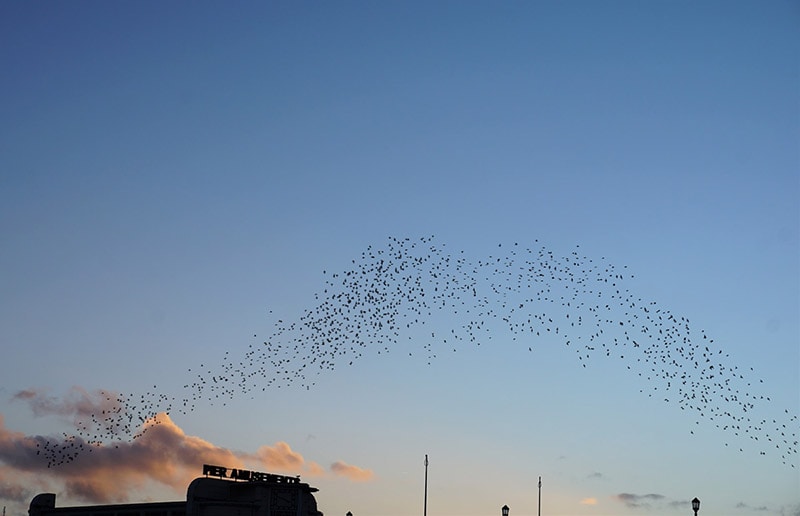What Are Starling Murmurations, & Why Do They Form? (The Science Behind It)
Last Updated on

Starlings are small to medium-sized birds with eccentric glossy black feathers. You may have seen these birds gathering in large flocks and flying in the air in perfect coordination. They don’t just fly but twist, swirl, and turn in multiple directions. If you’re a birdwatcher, this could be your favorite sky show.
Many people believe that “starling murmurations” refers to the birds’ singing. However, it actually represents the huge groups of starlings coming together and moving across the sky in different shapes.
Until now, many experts have researched how and why starling murmurations form. While there are many hypotheses, a murmuration is typically formed when one starling imitates the behavior of seven birds flying close by in the flock. Similarly, other starlings also copy their neighboring seven birds. This keeps going until the entire flock starts moving as one.
But what’s the science behind starling murmurations? Let’s dig deeper to find our answer.

The Science Behind Starling Murmurations
A study in the Proceedings of the National Academy of Sciences tried to find the reasoning behind starling murmurations. The researchers believed that the “scale-free correlation” between the birds leads to murmurations.
The scientists applied magnetism and velocity laws of physics to the starling groups. They found that birds behave like electrons—how they move when their close-by particles are magnetized.
The science behind starling murmurations dates back to the 1930s. At that time, a scientist proposed that starlings possess psychic powers that help them fly and coordinate together in flocks. But, of course, this doesn’t sound practically possible. So, let us see what modern scientists have found.

The First Simulation of a Bird Flock
In 1987, Craig Reynolds—a computer scientist—designed a simulation of a group of birds on the computer. He called them “boids.” Craig only used three simple rules to produce different movement patterns of the flock. The first was nearby birds moving apart, the second was birds aligning their direction and speed, and the third was distant birds moving closer.
Later, many movies used a few of these flock patterns to create realistic starling murmurations. Batman Returns (1992) is one example of such a movie. Remember the swarms of penguins and bats in the sky? Yes, that’s precisely what we are talking about.
Craig’s model didn’t require any sort of long-range guidance or psychic powers. Instead, it was based solely on local interactions, proving that a large group of birds can move together by following the basic rules. Also, the model looked like a real starling murmuration.
3-D Model of the Simulation
Craig’s model became the foundation of understanding the science behind starling murmurations. Soon, many animal movement simulations began to appear. Matching these models with the actual murmuration was a big challenge, which was finally achieved in 2008.
A group of Italian researchers recorded real starling murmurations near Rome’s railway station. Then, they changed the birds’ positions in 3-D, following certain rules. They found that a starling copies the speed and direction of its nearby seven birds instead of responding to every bird in the flock.
The 3-D model also gave a new perception of the starling murmuration. We can have three aspects when observing the pulsating waves and different twirling shapes. First, the birds slow down in some areas. Second, they become thickly packed in a few instances. Third, they accelerate and spread apart from each other.
Thanks to theoretical physicists and computer scientists, we now know how starling murmurations are formed.

Why Do Starlings Swarm?
Starling murmurations look like synchronized clouds moving in the sky over the birds’ roosting area. A roost is a place where starlings choose to rest for the night. That’s why you’re likely to see starling murmurations at sundown.
But the real questions are: “Why do starling murmurations form? Is it something the birds like or are forced to do?”
Scientists have concluded many reasons for starling murmurations. The three prominent ones include the following:
To Deter Predators
Starling murmurations work the same way as a school of fish swarms and move in the ocean to prevent predators. As predators start chasing a group of fish, they instantly move from one direction to another. This exhausts their predators, and they stop chasing them. Many scientists believe starlings swarm for the same reason.
According to one hypothesis, starlings move in a choreographed manner to intimidate predators, like falcons and hawks, from attacking them. Flying in groups confuses the large predators and lowers the risk of an individual starling being eaten by them.

To Roost
Another hypothesis focuses on the birds’ body heat. A murmuration invites other starlings present in a particular area to gather and roost. That’s why starling murmurations usually occur in winter. More and more starlings swarm at one central roosting site and regain body heat.
However, the roost is even more prominent in the late summer, consisting of about 100,000 or more birds. The birds gather just to survive in harsh conditions.
The ideal roosting sites for starlings are dense hedges, scaffolds, and reed beds. The birds swarm and pack themselves into any of these locations, usually 500+ birds per cubic meter. The flock can be even larger than several million.
Roosting also helps starlings confuse their predators. No bird wants to be the first one that a predator targets, so they stay close to each other and swirl in large flocks. The main goal is to scare the predators off.
Some starlings also travel several kilometers away for roosting. However, they end up burning more energy in the commute than they could have saved by roosting in nearby warmer places. So, roosting might not be just for seeking warmth.
Safety and warmth could be one of the many reasons starling murmurations form. However, many scientists also believe that starlings assemble to make other birds aware of the environment. They share information about the food sources with other starlings to survive together. This phenomenon is called the “information center” hypothesis.
According to this hypothesis, when the food becomes hard to find, starlings start sharing information among big groups of birds. This behavior is somewhat similar to when honeybees share information about the location of flower patches among other bees. Birds that succeed in finding food share information overnight to help other birds benefit from it.
It makes sense, but there is still limited evidence to support this hypothesis. So, these are just assumptions, and experts haven’t reached one specific conclusion as to why starlings swarm.

How Are Starling Murmurations So Well-Coordinated?
As you know, starling murmurations don’t follow a route, plan, or leader. Instead, the murmurations look well-coordinated because the birds know how to observe and copy the behavior of others. When some birds start to swirl in a particular direction, nearby birds follow them and adjust their movement accordingly.
The Italian 3-D model also gave us a clear insight into a murmuration. It showed that the starlings aren’t actually as close to each other as they seem from the ground. They have a lot of space to wander, see their neighbor’s movement, and change their speed and direction with other group members. That’s how starling murmurations look perfectly aligned!
Biologists, physicists, and computer scientists are still working to know how different animals and birds move in particular directions. Who knows—this curiosity may help us in other fields too, such as coordinating autonomous vehicles in groups without collision.
When and Where Do Starling Murmurations Take Place?
Starling murmurations occur in the United Kingdom most frequently. But over the years, starlings have increased in numbers in the USA too.
In the late 19th century, a New York pharmacist named Eugene Schieffelin brought 100 starlings to the country. Today, there are about 200 million European starlings across the USA. They all are believed to come from the 100 starlings that Eugene brought.
Starlings spend their day separately searching for food, hunting, and flying here and there. When it’s about sundown, the birds come together and swarm in their roosting sites. Then, they start flying over their roosting areas giving us a beautiful sky display.
In the USA, starling murmurations usually take place in the winter. However, the exact months are November and December. So, if you want to witness starling murmurations, visit popular birding places in the country at sundown.

FAQs on Starling Murmurations
Starling murmuration is a simple phenomenon. Here are the shortest answers to all your questions regarding starling murmurations:
What Is a Starling Murmuration?
Starling murmurations refer to huge flocks of starlings that look like a cloud from the ground. The birds turn, twist, swoop, and swirl in full coordination, mainly just before sunrise or sundown. A murmuration is formed when starlings in small groups gather at one roosting site and fly over the area in unison.
Is There a Leader in a Murmuration?
Murmurations have no leader or plan. Different hypotheses suggest several things, but a largely accepted belief is that a starling copies the behavior of its nearby seven birds. The remaining birds do the same thing, and that’s how a starling murmuration looks so well-organized. In fact, around 750,000 birds gather and fly together.
Why Do Starlings Do This in Winter?
One of the reasons for starling murmurations is roosting and warming up. As the weather gets colder, thousands of birds come together and help each other retain body heat for survival. However, you may also see starlings gathering in summer. That could be for either sharing information or avoiding predators.
What Time of Year Is Ideal to See Starling Murmurations?
Starling murmurations usually happen when it starts to get colder. It could be as early as September or as late as November or December. If you live in the USA, you’ll likely see starling murmurations around mid-November. Be sure to reach a good hotspot at the right time, like before sunrise or sundown, to make the memory of a lifetime.

Conclusion
Starling murmurations are those eccentric sky displays that you see around winter. They look like a cloud moving in the sky. In reality, it’s a large group of starlings flying, swirling, and turning in full coordination over their roosting sites.
Starlings create murmuration to avoid predators, roost and retain their body heat, and share information about the best foraging locations. The birds do it mostly in winter, but you may also see the murmurations in summer.
The science behind how murmurations are so well-coordinated is that one starling copies the behavior of its seven neighboring birds. It adjusts its speed and direction according to them. The other follows the same, and that’s how starling murmurations look so beautiful!
See Also:
Featured Image Credit: Albert Beukhof, Shutterstock
About the Author Jeff Weishaupt
Jeff is a tech professional by day, writer, and amateur photographer by night. He's had the privilege of leading software teams for startups to the Fortune 100 over the past two decades. He currently works in the data privacy space. Jeff's amateur photography interests started in 2008 when he got his first DSLR camera, the Canon Rebel. Since then, he's taken tens of thousands of photos. His favorite handheld camera these days is his Google Pixel 6 XL. He loves taking photos of nature and his kids. In 2016, he bought his first drone, the Mavic Pro. Taking photos from the air is an amazing perspective, and he loves to take his drone while traveling.
Related Articles:
Binocular Magnification Chart: Numbers & Distances Compared
10 Types of Hummingbirds in Arkansas (With Pictures)
8 Types of Hummingbirds in Nebraska (With Pictures)
5 Types of Hummingbirds in Idaho (With Pictures)
3 Types of Hummingbirds in Mississippi (With Pictures)
8 Types of Hummingbirds in Kansas (With Pictures)
5 Types of Hummingbirds in West Virginia (With Pictures)
5 Types of Hummingbirds in Ohio (With Pictures)
